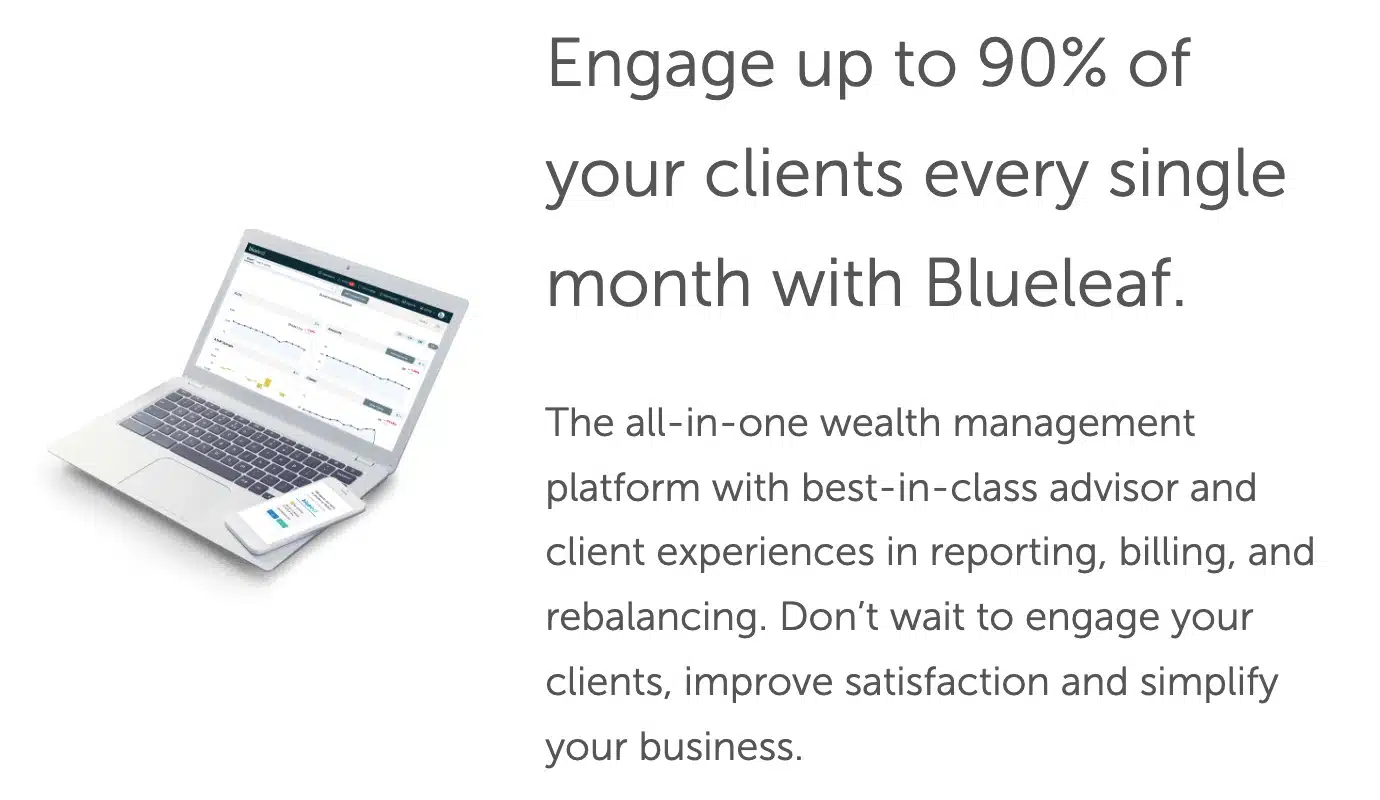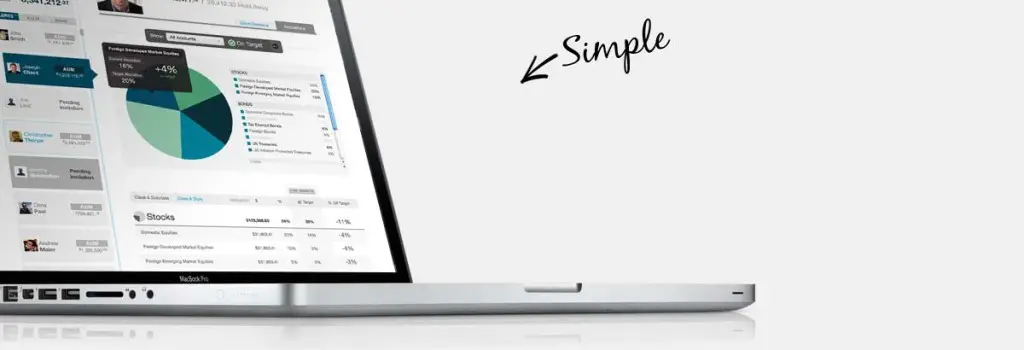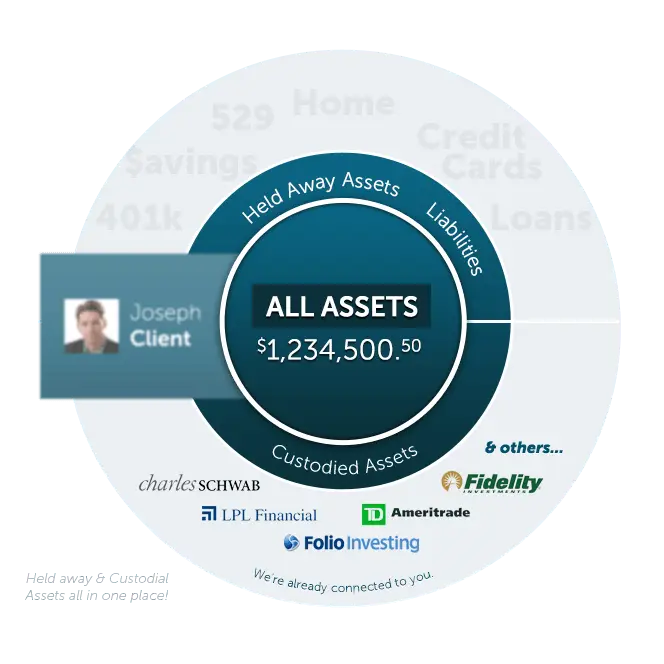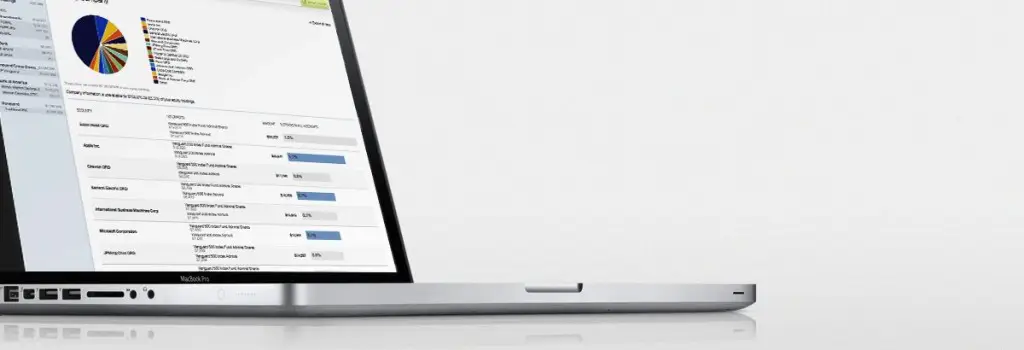The Blueleaf Advantage: Multiple Aggregation Options for Every Client and Every Account
That means: Better Connectivity,Better Coverage, and Fewer Headaches
Blueleaf is on a mission to make aggregation a better experience for advisors and their clients. While other platforms promise a better aggregation experience, the truth is no single aggregator can provide adequate coverage. This is why Blueleaf has added multiple retail aggregation alternatives that each client may use simultaneously. That means more institutions and better connectivity than anyone else on the market.
Retail aggregation technology has been challenging for advisors. In this guide, we explain all the challenges of working with aggregation to help you understand what is necessary to create a great experience. In this guide, we outline how aggregation works, why it’s important to clients, and what to look for to create an excellent experience for your clients and your firm.
What is Account Aggregation?
Account aggregation is one of the most powerful tools in a financial advisors’ toolbox.
Account aggregation automatically collects financial information from accounts at different institutions like your custodian(s) and clients’ held-away accounts, brings it to one place, and makes the information available to other systems. It eliminates the need to collect paper statements and manually key data into financial planning, performance reporting, CRM, client portals, or other systems.
One way to gather account data is through direct data connections. As the name implies, direct connections are linked directly between computer systems and are designed with the kind of consistency and specificity that computer systems require. That typically means the connections and data quality are very reliable. Maintaining these connections requires little to no attention from humans, making them the preferred method of connecting.
What Makes Aggregation So Difficult?
For various reasons, it is not typically possible to directly connect to accounts held by individuals outside of the control of a financial advisor. As a result, you have to use less reliable technical approaches like data scraping.
Data scraping allows a computer to sign in to another computer using a person’s security credentials and then find and extract information. Broken connections are the most significant issue when it comes to this method of aggregation.
Connections break for many different reasons, such as an update to an institution’s website, password change requirements, or more commonly these days, 2-factor authentication.
Additionally, most wealth management platforms only offer one aggregation partner. This limits the number of institutions that they can pull from reliably, thus limiting the data for advisors and clients.
Why can’t aggregation providers use reliable direct connections? The banks and credit card companies themselves have been resistant to enabling those connections for a variety of reasons:
- Desire to control the experience and force consumers to use only their systems.
- The cost of doing the work to enable it since building direct connection infrastructure is necessary.
- While security concerns are generally a smokescreen for the reasons above, building a secure system does add some upfront and ongoing costs.
However, things are slowly beginning to change. New technology standards are making these kinds of direct connections less expensive to build and maintain. That has encouraged institutions to take consumer demands for openness more seriously.
On the provider side, companies like Plaid and Yodlee have also upped their investment in pressing for these connections while increasing their focus on building and supporting them. As a result, we’ve started to see steady progress among the largest institutions to create stable, direct connections across more institutions.

Why It’s Important to Have Broad Coverage
For advisors
Account aggregation can be one of the easiest and fastest ways for an advisor to demonstrate value for a new prospect and improve service with existing clients. Aggregation benefits advisors in 8 key ways:
Simplify operations
Dramatically reduce the work of gathering and entering data. No more hassling clients to bring in statements, no more keying and re-keying their data, no more manual data-entry nonsense.
Accelerate asset gathering
Give new clients quick and easy data-sharing from day one with faster and easier access to their data.
Allow you to expand services offerings
Monitor and manage assets you previously couldn’t, and charge appropriate fees on held-away assets.
Improve client service
Advising clients on everything they own gives them full service with one provider, you.
Manage the “whole picture”
Having access to a client’s entire financial profile – what they have, where it is, how one account relates to another – allows advisors to use that knowledge to deliver comprehensive financial advice. Having adequate coverage of retail aggregation accounts is critical to have this complete view.
Be hassle-free with automatic data updates
Information for each synced account is accurate, up-to-date, and available online. This enables effective collaboration, reduces client questions, and allows advisors to spend more time on value-add services.
Deliver more value sooner
Using account aggregation during the prospecting process can have an enormous impact. The fastest-growing advisors use aggregation to gather data before they attempt to gather assets. This approach gives prospects a “try before you buy” experience with their financial advisor. As a result, closing rates skyrocket.
Enable proactive insight
Aggregation gives you access to all custodied/held away assets and liabilities. Because better account aggregation systems update at least daily, you can monitor your client’s assets with unprecedented vigilance. In many cases, that means you will know what is happening before the client.
Be a single hub for your business and clients
Aggregated data creates lots of opportunities to add value to your clients. Service possibilities include automated financial updates for clients and monitoring on held-away accounts so you can proactively solve client issues before they even know about them, and enhanced reporting and portal experiences for clients.
Additionally, a range of integrations means that you can bring data from other tools, CRM, and financial planning to get an even more complete view.
For clients
Many are using it already, and many more are signing up every day. Mint.com (15 million users) led this change, with others following closely behind. Personal Capital (an investment version of Mint.com) now has over 1.7 million users.
Clients expect their advisors to give them a 360-degree view of all their assets and liabilities— no matter where they hold them or who manages them. Younger clients are especially used to all their data being a mouse click away. They are sick of remembering lists of websites, passwords, user names, and security questions. Yet, they want to know where they stand.
Choosing Account Aggregation Software
 Advisors always highlight simplicity as something to look for in aggregation software.
Advisors always highlight simplicity as something to look for in aggregation software.
Some features to look for include:
Access to lots of institutions through multiple aggregators
This is arguably the most critical factor when choosing an aggregation partner. From Citibank to Green Mountain Credit Union, you’ll want a broad coverage of institutions across the country, big and small. This means that you don’t have to do manual updates. And since connectivity can vary across aggregators and even with a single aggregator over time, look for the availability of multiple aggregators within your wealth management platform.
All assets – one platform
You want custodial, held-away, offline assets and liabilities managed from a single platform, enabling you to monitor, report, and make decisions with context.
Client portal
You want the data presented well, so it makes sense to have a client portal as part of the package. You and your clients can then see balances, performance, allocation, and holdings – anytime, 24/7. It’s even better if the provider offers a mobile app where clients can access this data.
Performance reporting
The data also allows for performance reporting to be included. Reports that are always ready, on-demand online, or printed. There should be no more ‘running reports’ or hectic quarter-ends. You can eliminate traditional quarterly reporting altogether.
Proactive account monitoring
Aggregation data allows for automated monitoring of your client’s accounts with notifications.
Direct Client Support
Choose a provider who will work directly with your clients to ensure any issues are quickly resolved so your clients are happy and you’re not spending valuable time troubleshooting and diagnosing technical issues.
Here’s a 14 point aggregation checklist with expert tips
1. Clean, accurate data
Clean data with the availability of the largest possible number of institutions is vital. This means that you and your clients get the most comprehensive view of their net worth with the least hassle.
2. Multiple aggregation sources that provide an extensive range of institutions
A good aggregation provider should give you over 20,000 institutions as well as direct feeds to major custodians. However, to have the best coverage, having multiple aggregation providers is your best option. It should also be easy to add and maintain accounts on the system.
3. Growing available institutions
Some platforms are inflexible. You may have specific institutions that are not available, but you need to add them. Ask how many institutions the provider has added in the last 12 months. If an institution that you need is missing, ask how long it will take to add it. The correct answer is days.
Ask us about the institutions that we offer
4. Provides the lowest possible error rate
No account aggregation system is perfect. The system gathers data from a range of sources. These include custodians and financial institutions and feeds the data into one system. The challenge involves the lack of consistency and uniformity in the data. For example, what Schwab calls a “buy” is a “purchase” at Fidelity. Aggregation software should interpret these terms and understand that they mean the same thing. No manual fix is required.
Additionally, errors sometimes happen based on subtle changes. Custodian sites that can leave holdings with no descriptions or missing tickers. Sometimes even prices and quantities can be missing. Some systems do a better job of clean up than others.
Some target systems are less picky about data completeness than others. For instance, most traditional performance reporting systems need clean data to function. You need a system that cleans up and fills in data gaps.
- Offers more than one aggregation partner
- Normalizes data to make the numbers “apples-to-apples”
- Algorithmically reconciles data to ensure consistency
- Runs quality assurance analytics on the data
- Generates alerts about errors and outliers so issues are fixed before client even sees them
- )ptimizes data for portfolio management
5. Functionality that uses the data you have
Data is much more helpful if the system uses notifications. Looks for notifications that are real-time and customizable. Look for reporting, secure data sharing & collaboration technologies.
6. Advisor friendly pricing
Cost can and should be a concern. Some advisors will cherry-pick clients for this kind of ‘extravagant’ service which introduces problems of its own. Treating some clients one way and others a different way adds complexity to operations. How do we decide which clients to offer it to? How do we make sure that other clients don’t hear about the services we only want to provide to a few? It’s a minefield. Clients who may not be the largest today are often the future of our business. Giving it to the ones we want to grow is an excellent use of account aggregation.
Aggregation pricing should let you offer aggregation as a standard. All your clients and select prospects get it. Look for charges by the client with no limit on the number of accounts per client.
7. Highest available value
The data is too valuable to just aggregate accounts. The system can help you fundamentally change the nature of your business. It should help you:
It should help you:
- Move from an investment advisor to a wealth partner
Aggregation is all about providing a comprehensive view of a client’s net worth. This includes not just investment but held away assets and liabilities.
Blueleaf tip:Don’t assume that you know about all your clients’ assets. One new Blueleaf Advisor called concerned that the system had an issue. It showed that one client had a net worth of $6M when the advisor knew they had only $2M. More research showed that $6M was correct. Within a year, the advisor was managing those assets.
- Grow existing accounts
Many advisors don’t bill on held-away assets because they don’t know how to. Advice on held-away assets is an extra service offering and you should be compensated for that service. Advising on held-away accounts involves research, recommendations, and often rebalancing instructions.
By advising on held-away accounts, you not only create new value for your clients but also create an extra revenue stream for your firm.
- Increase win rates for new prospects
“Getting organized” with their finances is a top goal of many prospects. Getting access to your prospects at the right time in the sales cycle is a powerful way to show value. It also lets you better assess their growth potential as a client.
8. Ease-of-Use
It should be easy for you to invite prospects and for them to set themselves up. A good test is how many clients complete the setup. Ask for usage statistics to test this.
Aggregation should be simple for the advisor as well. In some aggregation systems, setup and operations can be labor and time-intensive. It can take weeks just to review and buy a new system. Good aggregation systems should only take minutes to set up.
Blueleaf tip: Watch out for “training.” Extensive training could indicate that the aggregation system is challenging to use and could result in lost time for you, the staff, and each client.
9. All-in-one functionality
The provider should include other vital systems such as a client portal, document management, invoicing, and reporting. These are relevant as your clients get a consistent and more straightforward user experience which means a reduced client learning curve and the elimination of many support calls.
10. Integrations – Easy, Fast and Simple
Ask if the technology is an open system. Great new CRM and financial planning systems have emerged in the last couple of years. Acquisitions have changed the landscape. We want you to have the flexibility to take advantage of this innovation and do what is right for your business. Look for an open API that allows for deep integrations without manual work. The result is flexibility and a great user experience.
The truth is no system will have perfect coverage nor integration with every possible vendor, but some are better than others. Some make it simpler to create new integrations. A simple integration process means that you will get access to new systems faster. This is key to your future flexibility.
Blueleaf tip: Integrations are good, but the number of integration partners alone may be misleading. An integration for some vendors means being able to move data manually. Ask if the integrations are automatic, and then ask how long it takes to add a new integration. The correct answer is days. A long integration time means that the process is expensive for both sides of the integration. The story behind that is outdated technology. Fast and inexpensive means more integrations with more functionality.
11. Simple credential management by clients not the advisor
Most retail accounts, passwords, and security questions expire. Once the credentials expire, it will stop the flow of data into the system. This process can create a massive operational headache for the advisor. Some systems expect the advisor to solve the problem. The advisor can’t do anything other than pass the message along to the client. Ultimately, this game of back-and-forth can turn into a daily task for an advisor, creating work rather than relieving it.
The aggregation system should alert the clients and give them a simple update process. No advisor involvement is needed.
12. Support
Account aggregation can turn into aggravation. Ask the vendor what steps they take to make aggregation hassle-free. They should include the following
- A comprehensive roll-out plan
Expect personal help with implementation so you can get the most from your investment and the platform. From communicating with clients to helping you understand how other advisors use the platform successfully, having a true support partner is critical to success.
- Direct client service
There will be issues with setup and you shouldn’t be the one resolving them. Make sure that your vendor deals with all client issues as part of their service. Don’t become your aggregation provider’s free geek squad.
13. Simple business practice DNA
Simplicity is cultural. It is not just in the usability of the product. It needs to be present in every aspect of dealing with the product and the vendor. You want simplicity in technology, in the business relationship, and support. Look for a solution that is easy to trial and simple to set up an account. Focus on finding a system that doesn’t need training for you or your clients. It’s obvious.
Blueleaf tip: Look at the company behind the product. Are they burdened by a large company mentality or lean and agile? Do they have complicated contracts? What are the long-term obligations? Does the vendor have hefty minimums?
Buying aggregation services should be as simple as the service itself. If you can’t purchase the service on the same day that you’re ready, it should cause you to stop and think. If the vendor can’t make it easy to buy, how could they possibly make it easy to use?
14. Risk mitigation as a core feature
Aggregation technology should be built from the ground up to ensure that the benefits of aggregation don’t open up risks for the advisor.
- Compliance / Custody Risks
Advisors entering client’s credentials into the system is a bad idea. It is time-consuming. It also might mean that they have custody of those assets under the “custody rule” (SEC Rule 206(4)-2). An advisor should never see or have access to client credentials. You don’t want to stumble into “constructive custody” territory.
.
- Best interests / Suitability
Most advisors must follow standards of conduct in varying degrees. The recommendations they make must be in their clients’ best interests or be suitable. There is debate about how good an advisor’s recommendations are without the whole picture. You may need to prove that you’ve acted in a client’s best interest. This means an extensive paper trail of historical account data from held-away accounts. Your aggregation system should let you grow without requiring an army of people to maintain records.
Summary
The key to a successful advisory business is focusing on what matters – making your clients happy with your service as soon as possible and providing support. The right aggregation system will allow you to do those things better than anyone else out there. Aggregation can help you win.


